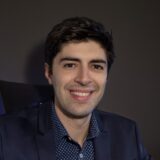Big Tech giants Apple (AAPL) and Microsoft (MSFT) saw their stocks decline after reporting earnings for the September quarter. Despite surpassing estimates, both fell short of market-high expectations, particularly in AI advancements and next-quarter guidance. Using the TipRanks Stock Comparison Tool, I will analyze the reasons behind this market reaction. My assessment suggests a neutral outlook for Apple and a bullish perspective for Microsoft, positioning it as a better buy post-earnings.
Don't Miss our Black Friday Offers:
- Unlock your investing potential with TipRanks Premium - Now At 40% OFF!
- Make smarter investments with weekly expert stock picks from the Smart Investor Newsletter

Let’s dive deeper.
Apple’s Fiscal Q4: Reduced Guidance and Uncertainty Surrounding the AI Supercycle
The Cupertino company reported its Fiscal Q4 earnings, which were poorly received by the market. This led to an initial stock decline of around 4%, contributing to my neutral outlook on the stock. Although Apple beat estimates on both top-and-bottom lines — reporting an EPS of $1.64 compared to the expected $1.60 and revenues of $94.93 billion versus a forecast of $94.58 billion—two negative factors likely influenced the bearish reaction.

The first concern was the guidance for revenue growth in the upcoming December quarter. Apple’s management projected growth in the low- to mid-single digits, specifically between 4% and 6%, while the market estimate was 6.8%. On a more positive note, Apple guided margins between 46% and 47%, exceeding the market expectation of 46.1%.
The second concern was the waning expectations in demand for AI-equipped iPhones. According to CEO Tim Cook during the earnings call, Apple will roll out more features in English-speaking countries—specifically the UK, Canada, Australia, and the US—leaving most of its markets waiting for updates. As a result, investors may have to wait several months to gauge how this story will unfold.
Is Apple a Buy, Hold, or Sell?
Although I am a long-term bull on Apple, I rate the stock as a Hold following its latest earnings report. This rating is primarily due to its valuation, which has been the main factor behind its underperformance compared to the S&P 500 (SPY) this year.
Looking ahead, following Apple’s Fiscal Q1 results, analysts expect Apple’s Fiscal 2025 EPS to grow by just 9%, with growth rates not exceeding 13% through Fiscal 2026. This results in a forward P/E ratio of 30.5x, which is still higher than the five-year average of 27.7x. It becomes even more challenging to justify this valuation when we account for growth, considering a projected EPS CAGR of 9.3% over the next three to five years. This leads to a PEG ratio of 3.2x—approximately 30% above its historical average.
While Apple is a top-quality company with a positive long-term outlook, it does not appear to be a compelling stock to buy at its current price. However, according to the Wall Street consensus, Apple is rated as a Moderate Buy. Of the 33 analysts covering the stock, 23 recommend a Buy, eight suggest a Hold and only two recommend a Sell. The average price target is $247.32, indicating a potential upside of 10.29%.

Microsoft’s Fiscal Q1: Concerns Over AI Spending and Cloud Slowdown
While I maintain a more favorable outlook for Microsoft, the market’s reaction to its Fiscal Q1 earnings was even more drastic than Apple’s. Microsoft’s Q1 results beat top-and-bottom-line estimates, delivering a $3.30 EPS compared to expectations of $3.10 and revenues of $65.59 billion versus the anticipated $64.51 billion. Despite these positive results, shares of the Redmond-based company fell by over 7.5% the following day.

However, I believe the primary reason for the post-earnings bearish reaction stems from the market’s high expectations regarding AI and its investments. Microsoft’s CFO, Amy Hood, stated that the company expects to incur a $1.5 billion hit to its income in the current period, mainly due to an anticipated loss from OpenAI, in which Microsoft has invested around $14 billion.
The other major point of concern was the slowdown in the cloud business. Azure’s year-over-year growth was 33%, a slight decline from the 34% growth in the previous quarter. In contrast, direct competitors like Alphabet’s (GOOGL) Google Cloud experienced a strong acceleration, increasing its year-over-year growth from 29% in Q2 2024 to 34.5% in Q3 2024, as reported just a day before Microsoft. Consequently, MSFT’s management guided Azure’s revenue growth to slow to the low 30% range in the next quarter, likely indicating some pricing pressure as competition intensifies.
Is Microsoft a Buy, Hold, or Sell?
I view Microsoft as a Buy following its Fiscal Q1 performance, as the market’s reaction seems excessive. Concerns about capital expenditures (CapEx) are notable, with spending increasing by 50.5% year-over-year in the September quarter, coinciding with a slowdown in Azure Cloud revenue growth.
Although Azure’s business is slowing, this is primarily due to current limitations in supply and capacity—conditions that should improve with the acceleration in AI investments. Microsoft anticipates a re-acceleration in Azure during the second half of its fiscal year, leading analysts to forecast EPS growth of 11.2% for Fiscal 2025 and 15.7% for Fiscal 2026.
This aligns with another factor supporting my positive outlook: valuation. Microsoft trades at a forward P/E ratio of 31.2x, consistent with its historical average. Adjusted for an expected EPS growth CAGR of 13% over the next three to five years, Microsoft’s PEG ratio is 2.4x—significantly lower than Apple’s.
Finally, the consensus among Wall Street analysts regarding Microsoft is also quite bullish. According to 30 analysts, 27 have issued Buy recommendations, while only three have rated it a Hold, forming a Strong Buy consensus. The average price target is $503.15, suggesting a significant upside of approximately 22.61%.

Conclusion
While the market reacted negatively to Apple and Microsoft’s earnings, I view Microsoft as the more attractive buy. Microsoft faced high expectations to sustain growth in its cloud business while ramping up investments in AI. I believe the growth story remains compelling at current valuations, especially with the potential for Azure to reaccelerate in the coming quarters.
On the other hand, Apple delivered decent results but guided revenue slightly below expectations, leaving investors uncertain about when the AI supercycle might positively impact its top-and-bottom- lines. This has led to less exciting projections, especially given Apple’s historically high valuations, which are becoming harder to justify. Consequently, I maintain a neutral stance on Apple and a bullish outlook on Microsoft.



















